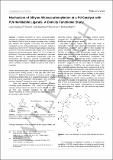Files in this item
Mechanism of alkyne alkoxycarbonylation at a Pd catalyst with P,N hemilabile ligands : a density functional study
Item metadata
| dc.contributor.author | Crawford, Luke | |
| dc.contributor.author | Cole-Hamilton, David J. | |
| dc.contributor.author | Drent, Eite | |
| dc.contributor.author | Buehl, Michael | |
| dc.date.accessioned | 2015-09-04T23:10:44Z | |
| dc.date.available | 2015-09-04T23:10:44Z | |
| dc.date.issued | 2014-10-10 | |
| dc.identifier | 158737346 | |
| dc.identifier | 3fa84fa4-fd53-4edd-ad10-ba9da0f34ac5 | |
| dc.identifier | 000343800700016 | |
| dc.identifier | 84941050001 | |
| dc.identifier | 000343800700016 | |
| dc.identifier.citation | Crawford , L , Cole-Hamilton , D J , Drent , E & Buehl , M 2014 , ' Mechanism of alkyne alkoxycarbonylation at a Pd catalyst with P,N hemilabile ligands : a density functional study ' , Chemistry - A European Journal , vol. 20 , no. 43 , pp. 13923-13926 . https://doi.org/10.1002/chem.201403983 | en |
| dc.identifier.issn | 0947-6539 | |
| dc.identifier.other | ORCID: /0000-0002-1095-7143/work/48131765 | |
| dc.identifier.uri | https://hdl.handle.net/10023/7405 | |
| dc.description | The authors thank the School of Chemistry and EaStCHEM for support. | en |
| dc.description.abstract | A detailed mechanism for alkyne alkoxycarbonylation mediated by a palladium catalyst has been characterised at the B3PW91-D3/PCM level of density functional theory (including bulk solvation and dispersion corrections). This transformation, investigated via the methoxycarbonylation of propyne, involves a uniquely dual role for the P, N hemilabile ligand acting co-catalytically as both an in situ base and proton relay coupled with a Pd0 centre, allowing for surmountable barriers (highest ΔG≠ of 22.9 kcal mol-1 for alcoholysis). This proton-shuffle between methanol and coordinated propyne accounts for experimental requirements (high acid concentration) and reproduces observed regioselectivities as a function of ligand structure. A simple ligand modification is proposed, which is predicted to improve catalytic turnover by three orders of magnitude. | |
| dc.format.extent | 4 | |
| dc.format.extent | 513235 | |
| dc.language.iso | eng | |
| dc.relation.ispartof | Chemistry - A European Journal | en |
| dc.subject | Alkynes | en |
| dc.subject | Density functional calculations | en |
| dc.subject | Homogeneous catalysis | en |
| dc.subject | Palladium | en |
| dc.subject | Reaction mechanisms | en |
| dc.subject | Palladium complexes | en |
| dc.subject | Carbonylation | en |
| dc.subject | Exchange | en |
| dc.subject | Esters | en |
| dc.subject | Model | en |
| dc.subject | QD Chemistry | en |
| dc.subject | BDC | en |
| dc.subject.lcc | QD | en |
| dc.title | Mechanism of alkyne alkoxycarbonylation at a Pd catalyst with P,N hemilabile ligands : a density functional study | en |
| dc.type | Journal article | en |
| dc.contributor.institution | University of St Andrews. School of Chemistry | en |
| dc.contributor.institution | University of St Andrews. EaSTCHEM | en |
| dc.identifier.doi | https://doi.org/10.1002/chem.201403983 | |
| dc.description.status | Peer reviewed | en |
| dc.date.embargoedUntil | 2015-09-05 |
This item appears in the following Collection(s)
Items in the St Andrews Research Repository are protected by copyright, with all rights reserved, unless otherwise indicated.

